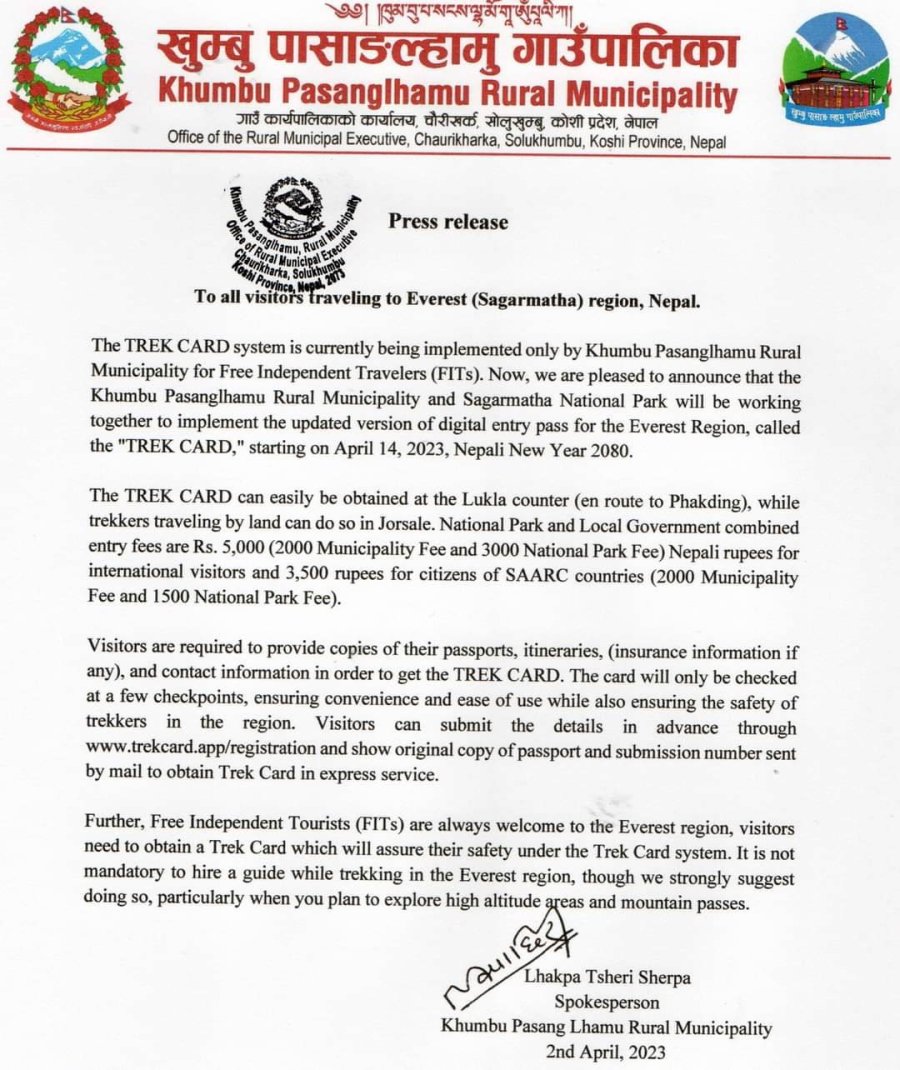April 4, 2023
KATHMANDU – The dispute between the Everest region and Nepal’s tourism promotional body has culminated over the mandatory guides and trekking permits.
A day after Nepal Tourism Board imposed the mandatory guides and trekking permits in 44 trekking trails, including a few in the Everest region, the Khumbu Pasang Lhamu Rural Municipality said they don’t have any obligation to follow the board’s rule.
“It is not mandatory to hire a guide for trekking in the Everest region,” the rural municipality under whose jurisdiction the Everest falls, said in a press statement. Nepali trekkers, however, are not required to hire a guide and pay the trekking fee.
“This is music to my ears,” commented Holly Stables, a United Kingdom national, on the rural municipality’s Facebook Post. “We arrive on 11th April and running the 3 passes! What a relief! Thank you Khumbu Pasang Lhamu Rural Municipality.”
“It will be very interesting to see what becomes of the conflict between the Trekking Agencies Association of Nepal (TAAN) and Nepal Tourism Board (NTB), on the one hand, and local officials from Solukhumbu, on the other. At the very core of this debate seems to be differing ideas about what federalism in Nepal actually means, in practice,” Stephen Sepaniak, said in a comment to the Post through an email.
“Under the new measures, many foreigners will likely try to hire guides before arriving in Nepal and undertake shorter treks. Treks booked from abroad often are far more expensive and much of this extra money will likely go to TAAN-affiliated brokers and middlemen in Kathmandu who charge additional fees to match prospective foreign trekkers with local guides,” Sepaniak said.
“Less money will flow to small-scale operators of tea houses and other small businesses inside the conservation areas — the very sort of businesses that have allowed locals in places like the Everest region to become comparatively well off — as foreigners will likely take shorter treks and will have more of their accommodations pre-arranged by middlemen in Kathmandu who will be the real beneficiaries of this new policy.”
Dhananjay Regmi, chief executive officer of the Nepal Tourism Board, told the Post that the new guidelines have already been implemented across the key trekking areas.
“It is highly irresponsible of the rural municipality in the Khumbu region not to follow it,” Regmi said. “Many trekkers travelling without guides have been lost or died due to terrain difficulties.”
“The rural municipality should either take responsibility for the safety of tourists, or else, they do not have the luxury to go against the new rule.”
Nilhari Bastola, president of the Trekking Agencies Association of Nepal (TAAN), said that the TIMS card would help in bringing quality trekkers.
“Apart from the safety of trekkers, it will be a decent source of income for the guides,” said Bastola. “It is just ridiculous of a local government to go against the new provision.”

Photo Courtesy: Khumbu Pasang Lhamu Rural Municipality
https://kathmandupost.com/money/2023/04/03/everest-region-nepal-tourism-board-dispute-over-solo-trek-ban-heats-up
Mingma Chhiri Sherpa, chairman of the Khumbu Pasang Lhamu Rural Municipality, said that the updated version of the digital entry pass for the Everest region called the Trek Card, will be implemented from April 14.
The rural municipality is the only one across the country which has implemented the card for free independent travellers (FITs).
The card can easily be obtained at the Lukla counter for the trekkers who come via air transport and for the trekkers coming via the land they can get them in Jorsale, according to the rural municipality.
The Sagarmatha National Park charges Rs3,000 per trekker as a national park entry fee and the rural municipality charges Rs2,000 for the trek card.
For SAARC nationals, the combined fee is Rs3,500—Rs2,000 for a trek card and Rs1,500 for the park entry fee.
The tussle, however, has worried tourism entrepreneurs.
Pasang Sherpa, a tourism entrepreneur, said it has created uncertainties.
“What kind of message are we trying to send internationally by collecting multiple fees from trekkers? Which should trekkers pay—TIMS or Trek Card?” Sherpa questioned.
Amid the objection of the rural municipality, the Nepal Tourism Board last Friday passed new guidelines for foreign trekkers, which bans foreign trekkers from visiting Nepal’s national parks and conservation areas without a guide or a porter for the entire journey.
The new rules say that the government-registered trekking company will arrange the guides or the porters.
The guidelines say foreign visitors also have to obtain a TIMS card before going trekking.
The new rule came into effect on Saturday.
The board has said it has introduced the guidelines because of the safety of trekkers and besides creation of jobs for the locals.
According to guidelines, a trekker found travelling on designated trekking trails without a guide or TIMS card faces a Rs12,000 fine.
A trekking company taking trekkers on trips without a TIMS card will be fined Rs10,000 per trekker.
Officials of diplomatic missions and development partners and their families will be charged Rs500 per TIMS card. It is not required if they are going on an official visit.
Once issued, the card will be valid for 90 days.
Industry insiders say the board brought the guideline as per the lobby of the Trekking Agencies Association of Nepal. In 2012, the association tried to enforce a one-trekker, one-guide system but later it was found that the government had not given it the green signal. It was withdrawn immediately.


